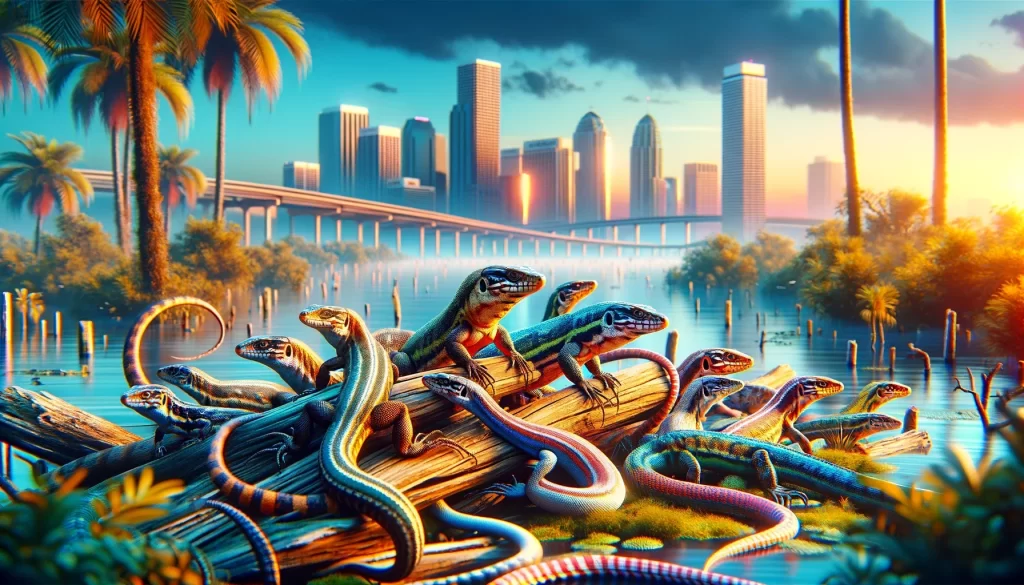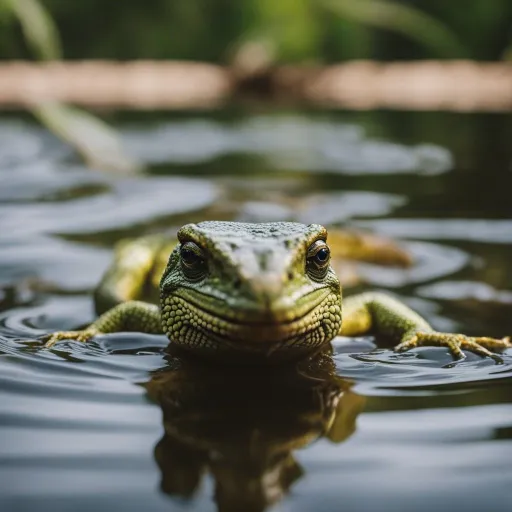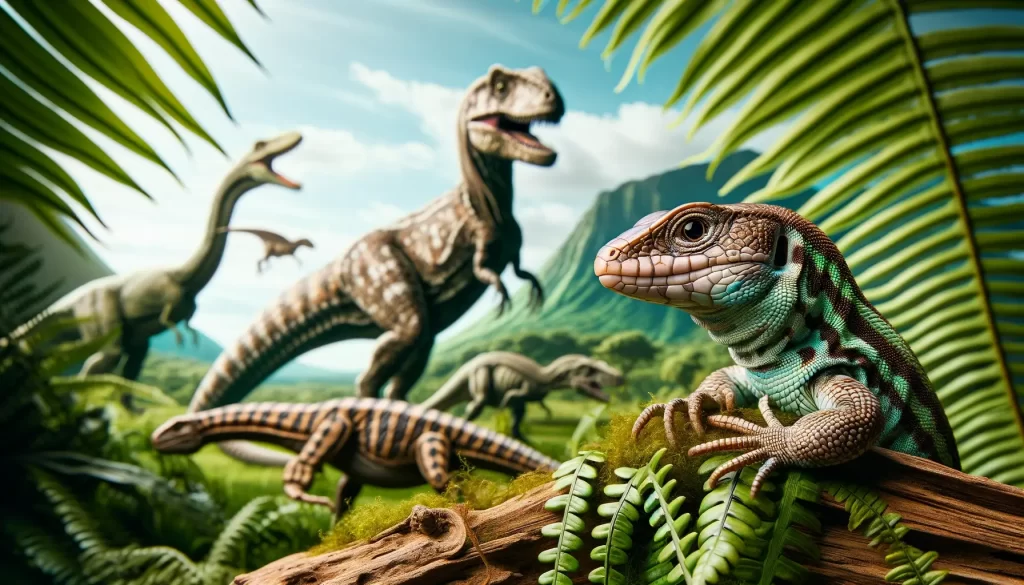
Have you ever wondered if lizards and dinosaurs coexisted in the ancient world? This article explores the intriguing question of whether these reptiles shared the same habitats millions of years ago.
By examining fossil evidence and scientific theories, we delve into the possibility of lizards roaming the Earth alongside the mighty dinosaurs.
From the discovery of ancient lizard fossils to the study of modern-day reptiles, this article uncovers the fascinating connection between lizards and the prehistoric giants that once dominated the planet.
The Evolution of Reptiles and Dinosaurs
The emergence of reptiles
Reptiles, a class of vertebrates that includes snakes, turtles, and crocodiles, first emerged over 300 million years ago during the Carboniferous period.
They evolved from amphibians and soon became dominant on land due to their ability to adapt to a wide range of environments.
The development of scaly skin and the ability to lay amniotic eggs were key adaptations that allowed reptiles to thrive in diverse ecosystems.
The rise of dinosaurs
Dinosaurs, a subgroup of reptiles, appeared around 230 million years ago during the Triassic period.
They quickly became the dominant terrestrial vertebrates, evolving into a fascinating array of shapes and sizes.
The emergence of dinosaurs marked a significant shift in Earth’s ecosystems, as they played a vital role in shaping the Mesozoic era.
Different types of dinosaurs
Dinosaurs were a diverse group that can be classified into two main categories: Saurischia and Ornithischia.
Saurischian dinosaurs, characterized by their lizard-like hip structure, included the well-known and formidable theropods such as Tyrannosaurus rex and Velociraptor.
Ornithischian dinosaurs, on the other hand, had a bird-like hip structure and encompassed herbivorous dinosaurs like Stegosaurus and Triceratops.
The extinction of dinosaurs
The extinction of dinosaurs, known as the Cretaceous-Paleogene extinction event, occurred approximately 66 million years ago.
The exact cause of their demise is still a subject of scientific debate, but the leading hypothesis suggests that a catastrophic asteroid impact in what is now Mexico, coupled with volcanic activity, dramatically altered the Earth’s climate.
This sudden and drastic change in environmental conditions led to the extinction of dinosaurs and many other species.
The Evolution of Lizards
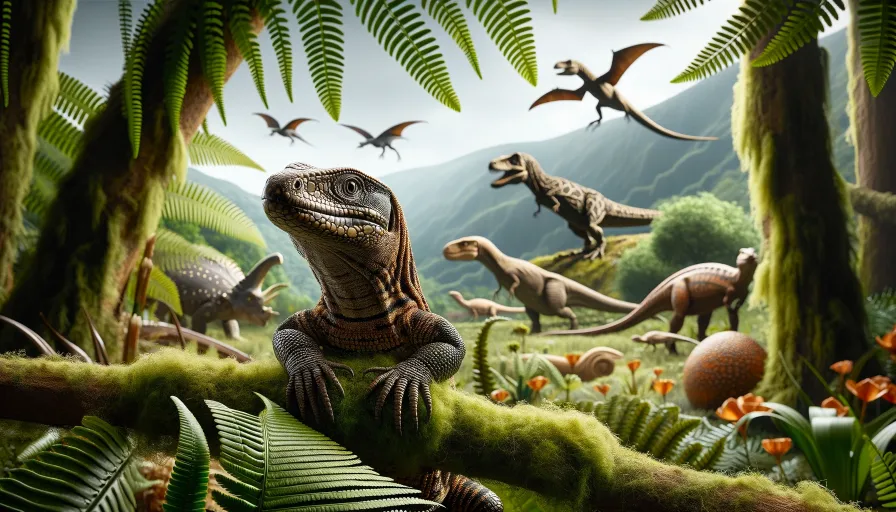
The ancestors of lizards
Lizards, a diverse group of reptiles, have a long evolutionary history dating back around 250 million years.
They evolved from small, lizard-like ancestors known as lepidosaurs during the Triassic period.
These early lepidosaurs had elongated bodies, sharp teeth, and crawled on all fours. Over time, they diversified into various lineages, leading to the development of the lizards we see today.
The diversification of lizards
During the Jurassic and Cretaceous periods, lizards experienced a significant diversification and spread across various continents.
They occupied a wide range of ecological niches, adapting to different habitats and lifestyles.
Some became arboreal, living in trees and developing specialized toe pads for climbing, while others became terrestrial or even burrowing species.
The characteristics of modern lizards
Modern lizards exhibit a variety of physical and behavioral adaptations that allow them to survive in different environments.
They have scaly skin, well-developed lungs, and a highly efficient respiratory system. Most lizards are ectothermic, relying on the external environment to regulate their body temperature.
They have excellent vision, often possessing a third eyelid called a nictitating membrane, and many species also have the ability to regenerate their tails if they are damaged or detached.
Reptilian Coexistence with Dinosaurs
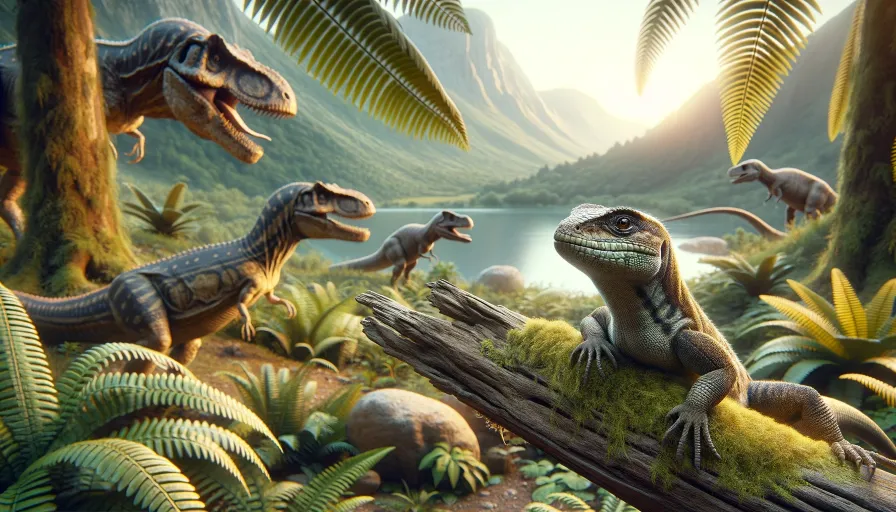
The age of reptiles
The Mesozoic era, often referred to as the “Age of Reptiles,” spanned from approximately 252 million to 66 million years ago.
During this time, dinosaurs and other reptiles, including lizards, coexisted and diversified.
While dinosaurs were the dominant land vertebrates, reptiles occupied various ecological niches alongside them.
The ecological niches of reptiles
Reptiles had an incredible range of ecological diversity during the Mesozoic era. Some reptiles, such as crocodiles and turtles, occupied aquatic habitats like rivers, lakes, and oceans.
Others, like certain lizards and pterosaurs, lived in terrestrial environments. The ability of reptiles to adapt to different habitats and lifestyles allowed them to coexist with dinosaurs without direct competition.
Reptiles as prey for dinosaurs
Although dinosaurs were the top predators of their time, reptiles served as important prey species. Small lizards and other reptiles were likely food sources for a variety of dinosaurs.
Fossil evidence indicates that certain dinosaurs possessed specialized dental adaptations for consuming reptiles, such as the serrated teeth of the theropod dinosaur, Coelophysis.
Reptiles as companions of dinosaurs
While reptiles were certainly preyed upon by some dinosaurs, it is also possible that certain reptiles established symbiotic relationships with dinosaurs.
For instance, some lizards may have acted as cleaners, feeding on parasites or dead skin of dinosaurs.
This mutualistic interaction would have benefited both the reptiles and the dinosaurs by maintaining hygiene and reducing the risk of infection.
Lizard-like Dinosaurs
The lizard-like features of dinosaurs
Dinosaurs and lizards share several anatomical similarities, leading to the description of certain dinosaurs as “lizard-like.”
These features include elongated bodies, scaly skin, and similar hip structures. However, it is important to note that dinosaurs are not direct ancestors of modern lizards, but rather distant relatives that evolved alongside them.
Examples of lizard-like dinosaurs
Several dinosaur species exhibit characteristics reminiscent of modern lizards. One notable example is the Coelophysis, a small theropod dinosaur that had lizard-like proportions and features.
Its agile body, sharp teeth, and long tail all bear resemblance to modern-day lizards. Similarly, the nodosaurs, a group of herbivorous dinosaurs, had armored skin that resembled the scaly appearance of lizards.
Lizards in the Jurassic Period
Fossil evidence of lizards in the Jurassic period
Fossil evidence reveals that lizards existed during the Jurassic period, which spanned from approximately 201 million to 145 million years ago.
Fossils of early lizard species, such as Ardeosaurus, have been found in Europe, providing valuable insights into the evolution and diversification of lizards during this period.
The environment and climate of the Jurassic period
During the Jurassic period, the Earth’s climate was generally warm and humid, creating lush tropical environments.
This climate provided ideal conditions for the diversification and proliferation of reptiles, including lizards.
They inhabited a wide range of habitats, from dense forests to open plains, thriving alongside dinosaurs and other reptiles.
Recent Discoveries and Controversies
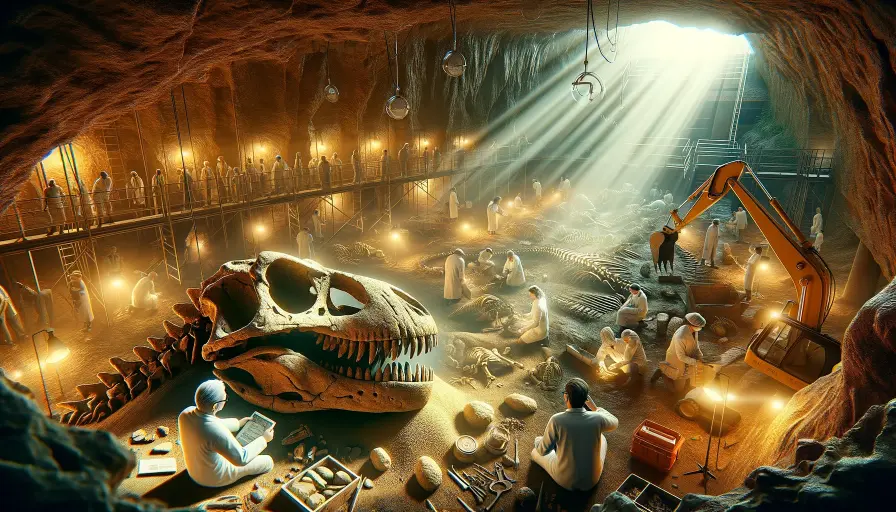
New fossil findings
Recent discoveries of well-preserved fossils have shed new light on the coexistence of lizards and dinosaurs.
These findings have provided valuable information about the interactions and relationships between these ancient reptilian groups.
Studying these fossils allows researchers to reconstruct past ecosystems and gain a better understanding of the evolutionary history of both lizards and dinosaurs.
The debate over direct coexistence
While evidence suggests that lizards and dinosaurs coexisted during the Mesozoic era, the extent of their direct interactions is still a subject of scientific debate.
Some researchers argue that lizards likely occupied different ecological niches and avoided direct competition with dinosaurs.
Others propose that lizards may have had more intimate relationships with dinosaurs, acting as their companions or even as their prey.
Conclusion
The evolution and coexistence of reptiles and dinosaurs during the Mesozoic era is a fascinating subject of study.
Reptiles, including lizards, emerged as a dominant group long before the rise of dinosaurs. They occupied various ecological niches and served as both predators and prey.
While dinosaurs and lizards shared some physical traits, such as scaly skin and lizard-like proportions, it is important to recognize that dinosaurs are not direct ancestors of modern lizards.
Fossil discoveries and ongoing research continue to provide new insights into the complex relationships between these ancient reptilian groups, enhancing our understanding of the Earth’s distant past.


